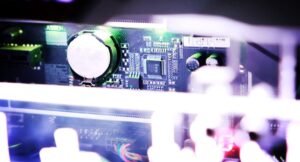AI: Top-Down, Bottom-Up
Artificial Intelligence (AI) is rapidly transforming various industries, from healthcare to finance. Two common approaches used in AI development are top-down and bottom-up. Understanding the differences between these approaches can shed light on how AI systems are designed and developed.
Key Takeaways
- Top-down and bottom-up are two approaches in AI development.
- Top-down starts with a broad understanding and narrows down to specific tasks.
- Bottom-up starts with specific tasks and gradually builds a broader understanding.
Top-Down Approach
The top-down approach in AI development starts with a broad understanding of a problem or concept and then narrows down to specific tasks. It focuses on creating a high-level representation of knowledge or rules that can be applied to solve specific problems. The top-down approach often requires extensive expert knowledge and domain expertise to define the rules and knowledge hierarchy. By using a predefined knowledge structure, the AI system can efficiently apply the acquired knowledge to solve complex problems.
The top-down approach enables AI systems to leverage existing knowledge and provide high-level reasoning capabilities. This approach benefits domains where expert knowledge plays a crucial role, such as medical diagnosis or legal reasoning. However, it may struggle with handling unforeseen situations or adapting to new information that doesn’t fit within the predefined knowledge structure.
Bottom-Up Approach
The bottom-up approach in AI development starts with specific tasks and gradually builds a broader understanding of the problem or concept. It focuses on learning from data and extracting patterns or rules to solve more complex problems. The bottom-up approach relies on machine learning algorithms, neural networks, and data-driven techniques to acquire knowledge and improve performance over time.
By leveraging large datasets, the bottom-up approach enables AI systems to discover hidden patterns and adapt to new information in real-time. This approach is well-suited for domains where data availability is high and the problem space is constantly evolving, such as natural language processing or image recognition. However, it may lack the ability to reason at a high level or provide detailed explanations for its decisions.
Comparison of Top-Down and Bottom-Up Approaches
| Aspect | Top-Down | Bottom-Up |
|---|---|---|
| Knowledge Availability | Requires explicit knowledge and predefined rules. | Relies on data and pattern extraction. |
| Expert Involvement | High, requires significant domain expertise to define rules. | Less, focuses on learning from data. |
| Handling Complexity | Efficient for complex problems with predefined structure. | Adapts to complex problems by learning from data. |
Applications of Top-Down and Bottom-Up Approaches
- Top-Down Approach:
- Medical diagnosis
- Legal reasoning
- Expert systems
- Bottom-Up Approach:
- Natural language processing
- Image recognition
- Speech recognition
Conclusion
Both top-down and bottom-up approaches have their strengths and weaknesses in AI development. The top-down approach facilitates high-level reasoning but may struggle with adapting to new information. On the other hand, the bottom-up approach excels in learning from data and adapting to new situations but may lack high-level reasoning capabilities. The choice of approach depends on the specific requirements and characteristics of the problem or domain at hand.

Common Misconceptions
Top-Down Approach to AI
One common misconception about AI is that it is developed using a top-down approach, where programmers simply write a set of rules and the AI follows them. However, this is not the case in modern AI development.
- Modern AI development uses complex algorithms and machine learning techniques.
- AI systems are trained using large datasets to learn patterns and make predictions.
- An AI’s behavior is not pre-determined but evolves through continuous learning and adaptation.
Bottom-Up Approach to AI
Another misconception is the idea that AI can be developed from the ground up, mimicking human intelligence. While AI can simulate certain aspects of human intelligence, it is important to understand that AI is fundamentally different from human cognition.
- AI systems lack consciousness or understanding of their actions.
- AI relies on algorithms and mathematical models to process data and make decisions.
- The goal of AI is to perform specific tasks efficiently, not to replicate human thought processes entirely.
AI as a Threat to Humanity
There is a fear among some people that AI will surpass human intelligence and pose a threat to humanity, as portrayed in popular media. While AI development raises ethical concerns, the idea of a sentient and malevolent AI is largely a misconception.
- AI systems are designed to perform specific tasks and lack the ability to have desires or intentions.
- AI is dependent on human input and supervision, and its outcomes are determined by the data it is trained on.
- Ensuring appropriate safeguards and regulations can mitigate potential risks associated with AI development.
AI’s Ability to Replace Human Labor
Many people believe that AI will replace human jobs, leading to mass unemployment. While AI does have the potential to automate certain tasks, it is unlikely to completely replace the need for human labor.
- AI is more effective at performing repetitive and data-driven tasks.
- Human workers possess skills such as creativity, problem-solving, and emotional intelligence that are not easily replicated by AI.
- The role of AI is more likely to assist humans in their work rather than completely replace them.
AI as Superintelligent Beings
Some misconceptions arise from the belief that AI is comparable to superintelligent beings with advanced cognitive abilities. However, AI systems are highly specialized and lack the broad range of intelligence that humans possess.
- AI excels at performing specific tasks but struggles with tasks outside its area of expertise.
- Human intelligence encompasses a wide spectrum of skills and adaptability that AI currently lacks.
- While AI can surpass human performance in certain domains, its overall cognitive abilities are limited.

Artificial Intelligence (AI) is rapidly transforming industries and reshaping the way we live and work. One of the key approaches in AI development is the top-down and bottom-up strategies. The top-down approach focuses on using high-level knowledge and understanding to drive AI decision-making, while the bottom-up approach emphasizes the use of data-driven and sensory inputs to build intelligent systems. In this article, we explore the benefits and challenges of these approaches.
1. AI Adoption Rates across Industries:
+———————————–+—————–+
| Industry | AI Adoption |
+———————————–+—————–+
| Healthcare | 62% |
| Manufacturing | 49% |
| Finance and Banking | 75% |
| Retail | 34% |
| Transportation and Logistics | 58% |
+———————————–+—————–+
The table above highlights AI adoption rates across different industries. It shows that finance and banking have the highest adoption rate, while retail lags behind. This data demonstrates the potential impact of AI in various sectors.
2. Advantages of the Top-Down Approach:
+—————————————-+———————————–+
| Benefits | Examples |
+—————————————-+———————————–+
| Ability to draw conclusions | Medical diagnosis |
| Incorporates domain knowledge | Autonomous vehicles |
| Can handle complex decision-making | Natural language processing |
+—————————————-+———————————–+
The top-down approach allows AI systems to utilize existing knowledge and make informed decisions. This table provides examples of how this approach benefits fields such as medicine, autonomous vehicles, and natural language processing.
3. Drawbacks of the Top-Down Approach:
+—————————————-+———————————-+
| Challenges | Examples |
+—————————————-+———————————-+
| Susceptible to biases | Racial or gender profiling |
| Limited ability to learn from data | Adapting to new environments |
| Difficulty with unknown scenarios | Unexpected system behavior |
+—————————————-+———————————-+
While the top-down approach has its advantages, it also poses challenges. Biases, limited data adaptability, and difficulties in unknown scenarios are prevalent issues. Overcoming these challenges is essential to ensure reliable AI systems.
4. Benefits of the Bottom-Up Approach:
+—————————————-+———————————-+
| Advantages | Examples |
+—————————————-+———————————-+
| Ability to learn from data | Machine learning algorithms |
| Adaptability to new situations | Robot navigation |
| Recognition of patterns and trends | Predictive analytics |
+—————————————-+———————————-+
The bottom-up approach leverages data to train AI systems, enabling them to learn, adapt, and recognize patterns. Examples include machine learning algorithms, robot navigation, and predictive analytics.
5. Limitations of the Bottom-Up Approach:
+—————————————-+——————————-+
| Limitations | Examples |
+—————————————-+——————————-+
| Lack of domain knowledge | Medical diagnosis |
| Vulnerability to noisy or biased data | Image recognition |
| Prone to overfitting | Stock market predictions |
+—————————————-+——————————-+
The bottom-up approach may struggle with a lack of domain knowledge, noisy or biased data, and overfitting. These limitations should be addressed to ensure accurate and reliable AI systems.
6. Hybrid AI Approaches:
+—————————————-+———————————-+
| Approach | Description |
+—————————————-+———————————-+
| Reinforcement Learning | AI learns through interactions |
| Deep Learning | Mimics the human brain |
| Symbolic Systems | Logical rule-based reasoning |
+—————————————-+———————————-+
Hybrid AI approaches combine elements from both top-down and bottom-up strategies. Reinforcement learning, deep learning, and symbolic systems are examples of techniques that blend different approaches for improved AI capabilities.
7. Ethical Considerations:
+—————————————-+———————————-+
| Ethical Issues | Impact on AI Development |
+—————————————-+———————————-+
| Bias and Discrimination | Unfair or harmful outcomes |
| Security and Privacy | Data breaches or surveillance |
| Job Displacement | Automation of human tasks |
+—————————————-+———————————-+
AI development must consider ethical implications. Issues such as bias, security, privacy, and job displacement require careful attention to ensure the responsible and ethical implementation of AI systems.
8. Achievements in AI Research:
+—————————————-+—————————————+
| Developments | Milestones |
+—————————————-+—————————————+
| AlphaGo defeating world champion | Game strategy and AI capabilities |
| GPT-3 generating human-like text | Language generation and comprehension |
| Self-driving cars navigating cities | Autonomy and perception |
+—————————————-+—————————————+
AI research has achieved various milestones, including AlphaGo’s victory, GPT-3’s text generation, and self-driving cars’ navigation. These breakthroughs highlight the progress made in AI capabilities and applications.
9. AI in Daily Life:
+—————————————-+———————————-+
| Everyday AI Use | Examples |
+—————————————-+———————————-+
| Virtual assistants (Siri, Alexa) | Voice commands and assistance |
| Predictive text in messaging apps | Autocorrect and suggestions |
| Recommendation systems (Netflix) | Personalized content suggestions|
+—————————————-+———————————-+
AI is becoming increasingly integrated into daily life. Virtual assistants, predictive text, and recommendation systems are just some examples of how AI enhances everyday experiences.
10. Future Outlook:
+—————————————-+———————————-+
| AI Developments | Anticipated Impact |
+—————————————-+———————————-+
| Healthcare improvements | Precision medicine and diagnosis |
| Advanced robotics and automation | Increased productivity and efficiency |
| Enhanced natural language processing | Improved human-computer interaction |
+—————————————-+———————————-+
The future of AI holds great promise. Anticipated developments in healthcare, robotics, and natural language processing are expected to bring significant positive impacts to society.
In conclusion, AI’s top-down and bottom-up approaches have distinct advantages and limitations. While the top-down approach harnesses domain knowledge, the bottom-up approach excels in learning from data. Hybrid AI approaches strive to combine the strengths of both strategies. As AI continues to evolve and shape our world, addressing ethical considerations and maximizing its potential will be crucial in ensuring a beneficial and responsible AI future.
Frequently Asked Questions
What is the difference between top-down and bottom-up AI approaches?
The top-down approach in AI involves starting with a predefined set of rules or knowledge and using them to make decisions or solve problems. The bottom-up approach, on the other hand, involves gathering data and information from various sources and using it to build knowledge and make decisions. While the top-down approach relies on a predefined structure, the bottom-up approach learns and adapts based on the available data.
How does the top-down AI approach work?
In the top-down AI approach, a designer or programmer defines a set of rules or knowledge that the AI system follows. These rules are typically based on expert knowledge or predefined logic. The AI system then uses these rules to make decisions or solve problems. This approach is often used in cases where the problem is well-defined and the rules can be explicitly stated.
What are the advantages of the top-down AI approach?
The top-down AI approach allows for precise control over the decision-making process. Since the rules are predefined, it is easier to understand and debug the system. This approach is also typically efficient in terms of time and computational resources required.
How does the bottom-up AI approach work?
The bottom-up AI approach involves gathering data from various sources and using it to build knowledge or models. This data-driven approach often employs techniques such as machine learning and data mining. The AI system learns from the collected data to make predictions or solve problems. It is particularly useful in cases where the problem is complex and difficult to explicitly define.
What are the advantages of the bottom-up AI approach?
The bottom-up AI approach can handle complex and ill-defined problems that may not have an explicit set of rules or knowledge. It is able to adapt and learn from the available data, leading to more accurate and flexible decision-making. This approach is especially effective in domains with large amounts of data and complex patterns.
Can top-down and bottom-up approaches be combined in AI systems?
Yes, it is possible to combine top-down and bottom-up approaches in AI systems. This hybrid approach leverages both predefined rules and data-driven learning. By incorporating expert knowledge with adaptive learning, the system can benefit from the strengths of both approaches. However, the integration of these approaches requires careful design and coordination.
Which approach is better, top-down or bottom-up?
The choice between top-down and bottom-up approaches depends on the specific problem and context. Both approaches have their advantages and disadvantages. The top-down approach is suitable for well-defined problems with explicit rules, while the bottom-up approach is better suited for complex and data-rich domains. It is often recommended to evaluate the problem requirements and available resources to determine the most appropriate approach.
Are there any limitations or challenges associated with top-down AI?
Yes, there are some limitations and challenges associated with the top-down AI approach. Since the rules are predefined, the system may struggle to handle complex or unpredictable situations that are not explicitly covered by the rules. Additionally, creating an accurate set of rules may require significant expertise and time. Regular updates and modifications may also be necessary as the problem domain evolves.
What are the potential drawbacks of the bottom-up AI approach?
While the bottom-up AI approach can handle complex and data-rich problems, it may require significant computational resources and data processing capabilities. The system’s performance heavily relies on the quality and quantity of available data. Additionally, interpretability and explainability of the system may be challenging due to the complex and iterative nature of the learning process.




